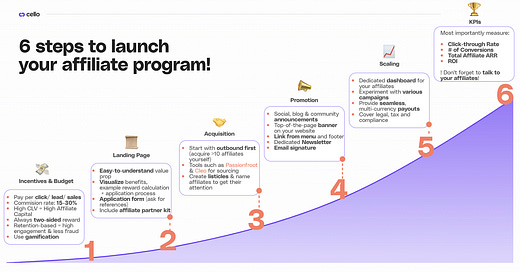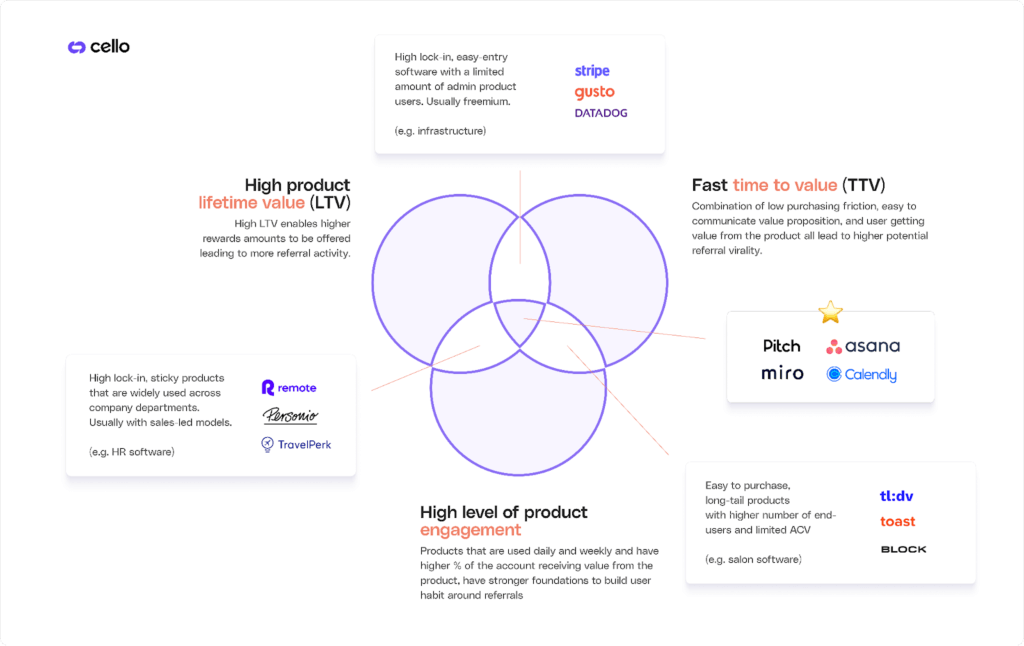Your ultimate guide to affiliate referrals for B2B SaaS
Is an affiliate program right for you? Learn how to set up and launch state-of-the-art affiliate programs.
Hey - it’s Alex - this time together with
!Welcome to Startup Business Tips, a bi-weekly newsletter, where I share with you 3 actionable growth tactics that will help you quickly grow your SaaS business from €0 to €1 million ARR 🚀.
Today we cover:
1️⃣ What are affiliate referrals & the 2 types of Referrals
2️⃣ The 6 different affiliate types
3️⃣ 6 steps to a Successful Affiliate Referral Program
👉 Bonus material - Complete Guide to your B2B Referral Program by
A quick word from our sponsor: Reviewflowz
📢 Take your review game to the next level in 2024
It shouldn't be harder to get reviews than to get happy customers. Reviewflowz helps SaaS companies with reviews & testimonials:
Build effective, "always-on" review campaigns
Share every new review on Slack, Zapier, or anywhere
Showcase your best reviews across your website
Want to reach 4500+ early-stage SaaS founders/leaders? Sponsor the next newsletter.
The ultimate guide to affiliate referrals for B2B SaaS - Overview
The ultimate guide to affiliate referrals for B2B SaaS covers:
What are affiliate referrals?
Why should I invest in an affiliate referral program?
What types of affiliate referrals are suited for you?
The 6 steps to a Successful Affiliate Referral Program
Closing Thoughts
In the fast-moving world of B2B SaaS, affiliate referrals are quickly becoming key to growth. With a market value exceeding $17 billion in 2023 (Google), experts predict it could reach $40 billion by 2030 (Astuteanalytica).
Not surprisingly, more than 81% of brands are already applying these growth loops (Statista). What works incredibly well, especially in B2C e-com, remains untapped for B2B SaaS.
This guide aims to demystify affiliate referrals, offering practical advice, tested strategies, and innovative approaches designed specifically for high-growth B2B SaaS companies.
Whether you're starting from scratch or looking to improve your existing program, this guide will provide the answers you need:
Does an affiliate program make sense for me and my product?
What types of affiliate referrals exist, and what are the pros and cons?
How to launch an affiliate referral program?
How and where to identify affiliates?
How to promote an affiliate program?
How to scale and maintain it?
What are KPIs to look for?
What are affiliate referrals?
We generally distinguish between user referrals and partner referrals. Affiliate referrals are a subcategory of partner referrals.
If we take one step back and look at the theoretical foundation of growth loops Casey Winter and Kevin Kwok defined affiliate referrals as a subtype of Paid Growth Loops.
New user sign-ups generate revenue and are reinvested in ads or content suppliers or partners distribute. The primary fuel of this loop is revenue.
Based on this theoretical foundation, we can define affiliate referrals as a growth channel where businesses incentivize external partners (affiliates) to promote their products or services to a broader audience.
These affiliates, from individuals to companies, earn a commission or other rewards for each customer or sale they generate through their referral links.
Now that you understand what affiliate referrals are, let’s have a closer look at what’s in it for you.
Why should I invest in an affiliate referral program?
Affiliate referrals aim to leverage cost-effective, scalable growth.
This approach taps into the networks of trusted affiliates to increase product visibility and credibility, driving targeted leads and conversions.
With affiliates generally paid on a performance basis, it ensures zero payback time and a high ROI by focusing expenditure on proven results.
Moreover, it enhances brand reach within niche markets through partners with established audiences, facilitating efficient market penetration and customer acquisition with minimal upfront costs.
Some stats in a nutshell:
As of May 19, 2023, affiliate programs drove 16% of all online orders in the United States (Demandsage)
A good 65% of retailers see up to a 20% increase in yearly revenue through affiliate marketing. Nearly 60% of merchants make $5 million, showing great revenue potential with good affiliate marketing strategies(Demandsage)
More than 80% of brands use affiliate marketing programs, allocating around 10% of their marketing budget to it (Forrester)
B2B affiliate programs account for 40.68% of all affiliate programs used by marketers, with SaaS products paying the highest commissions (Authorityhacker)
Before we try to understand if affiliate referrals are for you, let’s have a deep dive into the most prominent types of affiliates and see which type of company is most suited for them.
What types of affiliate referrals are suited for you?
We generally see the following 2 emerging forms of affiliate referrals.
Affiliate content creators: Online content creators who place affiliate links into their copy, visuals, or podcasts.
Affiliate hubs: Specialized websites that provide access to affiliates or enable affiliate link listings.
The below overview compares various subcategories of these two affiliate forms (the list is non-exhaustive) and indicates which one could work best for you.
Let’s move on and see whether an affiliate program is right for you.
Is an affiliate program right for me?
Deciding if an affiliate referral program is right for your B2B SaaS company hinges on the product's nature, complexity, and market fit.
Low to Medium Friction Products: These products are easily accessible (freemium or free trial product access), making them ideal for affiliate marketing. Affiliates can effectively communicate the product's benefits, appealing to a broad audience.
High-Friction Products or Narrow Audiences: These products face challenges due to their complexity or niche target market. Achieving success through affiliate marketing requires more effort, including significant upfront investment in affiliate education and a more time-consuming go-to-market strategy, relying heavily on the affiliates' influence and expertise. Choosing the right affiliate (s. Sourcing & Acquiring section) could still result in program success.
Trend-driven products: It's noteworthy that affiliates typically see a 47.16% higher earning from selecting products based on trends rather than commission rates or personal insights (Authorityhacker). This aligns with the initial point about the widespread appeal of AI tools among today's affiliates.
Natural limitation: Be aware that growth and scalability through affiliates might be naturally limited due to a shortage of suitable affiliates for your product.
In essence, while affiliate programs can significantly boost growth, their effectiveness varies based on product accessibility and audience specificity.
We’ve covered the theoretical foundation; let’s get more tactical and learn how to set up an affiliate program in 6 steps.
6 steps to a Successful Affiliate Referral Program
👉 Read the full Guide on Cello’s blog to learn about these 6 steps in detail.
1. Setting the right incentives & budget
Incentive structure:
Pay-per-click: The affiliate gets a reward for every successful unique click on a referral link
Pay-per-lead: The affiliates get a reward for an inbound lead or a specific event
Pay-per-sales: The affiliates get a percentage of the revenue generated by new paid customers
Allocate the right budget:
Between 20% to 70% commission is typically paid to SaaS affiliates (authorityhacker). The right budget depends on:
Average Customer Lifetime Value (CLV):
Profit Margins
Market Competition
Program Management Costs
Estimated Acquisition through Affiliates
Trial and Error
Other key variables to consider:
Two-sided rewards
Retention-based pay-per-sales
Payout Thresholds
Gamification and Incentives Tiering
2. Preparing your affiliate program landing page
The landing page should include:
✅Benefits and structure of your program
✅Your reward model
✅Payout terms (e.g. referral-based, one-off, lifetime)
✅Sign up form
✅Provide an affiliate partner kit (great example tl;dv)
Notion and Fellow.app are great examples.

3. Sourcing and Acquiring Affiliates - Outbound first
Now you need to acquire the right affiliates for your product. Tools like Passionfroot, Kleo, Taplio are great for finding your initial affiliate base.
4. Constantly promote your affiliate program - Inbound
A few recommended tactics are:
Announcements on your social accounts, blog, and communities
Embed website top-of-the-page banner highlighting your new partner program
Main navigation and footer backlinks should lead to your partner page
Encourage existing partners to share on their social about their program participation
Dedicated newsletter and/or inclusion in your nurture emails about the program
Include the affiliate program on your employee’s profiles and email signature
5. Scale and maintain
Once your affiliate is live, you need to keep track of:
✅Affiliate partner communication & performance
✅Affiliate dashboard
✅Payouts
✅Legal, tax & compliance
6. KPIs and Benchmark
Tracking input and output metrics allows you to decide if affiliate programs are a good fit for your GTM strategy (--> Free GTM Workbook).
Closing Thoughts
Affiliate referral programs have the potential to be a significant growth channel.
A few criteria that define success::
Product complexity & market fit
Structure of the affiliate program
Availability of suited potential affiliates
Your ability to enable & engage your affiliates
Your ability to scale the program
Finally, don’t forget the synergies between user referrals and affiliate referrals. Layer user referrals on top of affiliates once you have reached a significant monthly active user base (e.g. >1,000 MAUs).
👉 Read the full Guide on Cello’s blog to learn about these 6 steps in detail.
💪 Bonus material (software, content, news) - Complete Guide to your B2B Referral Program by
Kyle Poyar and Cello.so created an awesome Guide on how to get started with a SaaS referral program.
👉 Read the B2B Referral Program Guide
Happy growth 🚀.
3 ways I can help you grow your SaaS to €1 million ARR 🚀
Build your GTM strategy with my free SaaS GTM Strategy Workbook (helped 4500+ SaaS leaders)
Get access to 100+ actionable SaaS growth tactics (helped 250+ SaaS leaders) - 100% positive ROI guarantee.
Work 1-on-1 with me - GTM Advisory for early-stage SaaS founders on their way to €1 million ARR (1 free spot - limited to 8 founders).
For daily actionable tips to grow your B2B SaaS business, follow me on Linkedin.















